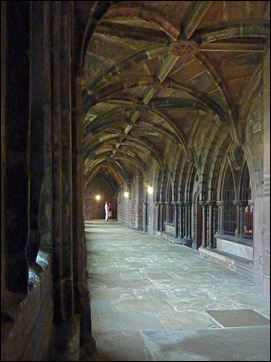|
The Cathedral part III |
A Virtual Stroll Around the Walls of Chester The Cathedral IV |
|
"Jesus entered the Temple area and drove out all those who were buying and selling there. He overturned the tables of the money changers and the benches of those selling doves. "It is written," he said to them, "My house will be called a house of prayer, but you are making it a den of robbers". (Matthew 21) |
 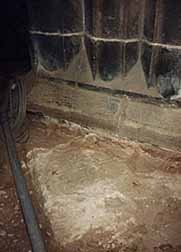 hould
you
be
tempted to
interrupt
our
stroll
around
the
City
Walls
for
a
while
to
visit
the
Cathedral- and
you
definitely
should-
you
will
find
the
nearest
entrance
in Abbey Square, at the end
of quiet, cobbled
Abbey
Street,
allowing
a
dignified
entry,
far preferable
to
the
main
entrance
in
St. Werburgh
Street,
where
one
is
forced
to
run the gauntlet of the 'visitor's
centre' and
associated
gift
shop
before
eventually
gaining
access
to
the
great
building
itself. hould
you
be
tempted to
interrupt
our
stroll
around
the
City
Walls
for
a
while
to
visit
the
Cathedral- and
you
definitely
should-
you
will
find
the
nearest
entrance
in Abbey Square, at the end
of quiet, cobbled
Abbey
Street,
allowing
a
dignified
entry,
far preferable
to
the
main
entrance
in
St. Werburgh
Street,
where
one
is
forced
to
run the gauntlet of the 'visitor's
centre' and
associated
gift
shop
before
eventually
gaining
access
to
the
great
building
itself.Despite considerable objection, in 1999, the Cathedral authorities saw fit to replace the 18th century nave floor with new stone, declaring the old surface to be "unsafe", and to have been worn "wafer-thin". Opponents said the Dean & Chapter undertook the work for reasons of mere cosmetics- and possibly also to protect themselves from legal action in the unlikely event of a visitor tripping and injuring themselves. The stone used was not the soft local sandstone from which the rest of the Cathedral is built, but a harder Permo-Triassic sandstone transported all the way from Dumfries in Scotland. At the same time, a system of underfloor heating was also installed and most of the characterful, if inefficient and noisy, Victorian 'Gurney' heaters were done away with.  Archaeologists
took
the
opportunity
to
conduct
an
investigation,
and this author was privileged to be able to observe and photograph their work. They were
only
being
allowed
a
short
time
on
site and only
permitted
to
explore
to
the
depth
where
the
new
heating
pipes
were
to
be
laid.
Of
course,
much
of
this
layer
had
already
been
thoroughly
disturbed
and
contains
little
but
18th
and
19th
century
graves. Archaeologists
took
the
opportunity
to
conduct
an
investigation,
and this author was privileged to be able to observe and photograph their work. They were
only
being
allowed
a
short
time
on
site and only
permitted
to
explore
to
the
depth
where
the
new
heating
pipes
were
to
be
laid.
Of
course,
much
of
this
layer
had
already
been
thoroughly
disturbed
and
contains
little
but
18th
and
19th
century
graves.Some very interesting discoveries were made however. For example, the base of a massive stone wall, 2.5 metres wide, of rough-faced small blocks, was found under the present Arcade. It may have formed part of the foundations of the Norman abbey church of c. 1092, but is unlike surviving Norman work elsewhere in the Cathedral. It was conjectured that it could be a relic of the even earlier Saxon church, of which virtually nothing is known, although the masonry is more massive than would be expected in a building of that period. Our illustration above shows a great slab of stone, faintly decorated with a floral motif, supporting one of the great pillars in the nave, exposed for the first time in centuries. Whatever the case, further investigation of what mysteries lie beneath Chester Cathedral must await the archaeologists of another century. During the Summer of 2002, the north side of the Cathedral was once again shrouded in scaffolding and surrounded by the noise and dust of the builders as work commenced upon the construction of a new Choir School above the ancient Chapter House entrance and on the site of the long-vanished monk's dormitories. When complete, we read in the local press, the new facilities would allow the Cathedral's boy's, girl's and men's choirs to carry out their daily rehersals under one roof, rather than in their present cramped conditions, and also to provide "a training ground for the professional singers of the future". The money to pay for it- around £2 million- was, hopefully, to be raised by appeal. The Cathedral and Abbey Square looking beautiful in the snow of January 2010 • Then, in late 2009, we heard the first of a £7.5 million plan "to make Chester Cathedral more visitor-friendly". Why so? Was there, then, something about the place that made it visitor-unfriendly? Aside from those intimidating admission charges of course. The stated aim was "to attract another 130,000 visitors a year". Behind the scheme was a partnership of the Cathedral authorities and the quango Chester Renaissance, whose stated (and laughably absurd, considering our record of attracting visitors of hundreds of years)- aim is to make Chester a "must-see city by the year 2015", but really just the latest in a tiresome succession of fiddlers with Chester's precious heritage, staffed by 'experts' hailing from places far away. Project management was co-ordinated with Building Design Partnership's (BDP) Liverpool office, designers of ultra-modern office blocks and shopping centres, including the vast and vile Liverpool One. So perfect for Chester then.
The consultation process involved the display of, to say the least, vague and sketchy plans in the Cathedral itself, in the planning department at the council and at the Cheshire Oaks shopping centre, of all places. Some of the proposals seemed attractive- improving facilities for the staging of concerts and events for up to 1,800 people, and the opening up of parts of the great building previously inaccessible to visitors, such as the 16th century Central Tower. Others perhaps less so- the construction of a new terrace restaurant and the insertion of a cafe into the base of the Addleshaw Bell Tower, for example. That traffic would continue to be able to drive through, and park in, this 'dignified' new open space also struck many as ludicrous in the extreme. At the heart of the Cathedral Green is Chester's War Memorial, which was put in place here amidst great ceremony in 1921. (Watch a short British Pathé newsreel of the event, and here is a film of the Prince of Wales laying a wreath there in 1926). Was this to be tidied away to some convenient place in order to make way for the 'improvements'? (Actually, the siting of the War Memorial caused somewhat of a stink when it was new. It was only sited on the Cathedral Green because both the city authorities and King's School had refused to allow it to be sited in the first choice of locations in Town Hall Square and there followed many calls for the railings separating it from the square to be removed.) And then we had the proposal to construct a new "iconic" (oh dear) visitor's centre pavillion stuck onto the Cathedral's south transept, an uber-modern and grossly inappropriate structure, early being described as the "Dinosaur's Egg", even though nobody outside of the elect ranks of the Cathedral authorities and Chester Renaissance had yet to lay eyes upon anything even resembling an 'artist's impression'. Chester Renaissance Chief Executive Rita Waters, whose photo these days seems to appear several times every week accompanying approving articles in the Chester Chronicle, said, somewhat cryptically (but utilising all of those obligatory, tiresome contemporary keywords), "it's not about funding the Church, it's about funding regeneration- whether it's a building or an open space- it's about regeneration and making sure the city continues to be sustainable. This is a hugely exciting and unique opportunity for the city to show its support for its cathedral which will continue to welcome and increase the many visitors it will bring into our city". Left: the War Memorial, erected here on the Cathedral Green in 1921. Below: people in the same area a few months later, relaxing and enjoying the Summer sunshine. Another fervent advocate of the proposals, CWAC spokesman for regeneration Councillor Herbert Manley, who represents Hartford, miles from Chester, is continuously being quoted as claiming the 'improvements' "could result in another 130,000 more annual visitors visiting the cathedral". Could? Martians could land in Town Hall Square but the likelihood seems just as remote. And meanwhile, on the other side of the Cathedral, much of the historic fabric of the splendid properties- many of them listed- for which the Dean & Chapter are legally responsible: Abbey Square, the great and small Abbey Gateways, the Deanery Field, the once-charming Deanery Cottage (seen below), the fine terrace of Georgian houses in Abbey Green and much more- have been neglected for years and are now shockingly bad condition (a gallery of photographic evidence will be appearing here shortly). Surely this is where money needs to be urgently spent rather than upon a mere vanity that absolutely nobody wants? A large proportion of the Cathedral's fine houses and commercial premises in Abbey Square, Abbey Green and elsewhere are left unoccupied and have been for some considerable time. Why? Wouldn't the rents obtained from letting these desirable properties come in handy to fund some of those pressing repairs?
In April / May 2010, as part of the consultation process, archaeologists were to be seen grubbing away in the area bordering the churchyard and St. Werburgh Street, attempting to ascertain how this boundary has changed over the centuries and also to establish the nature of the archaeology lying beneath the intended development area.
Left: one of the Cathedral's properties, the once-charming Deanery Cottage. Grass grows from guttering, windows are broken and the garden is riotously overgrown. Compare with the view of it in happier times on our front page... By November 2011, things seemed to have gone somewhat pear-shaped for architects and project managers, the mighty BDP who have already earned themselves hundreds of thousands of pounds from you and I, the Chester taxpayer. Their huge Tithebarn Development in Preston has just gone west thanks to the withdrawal of 'anchor' business John Lewis, their profits have halved and they have been forced to close a number of their regional offices- including the Liverpool one administering the Cathedral scheme- and laid off a goodly number of staff. 15th November 2011: Despite being, predictably, recommended for acceptance by planning officers, the Cathedral proposals were unanimously, and to the joy of many, thrown out by the Cheshire West & Chester Planning Board tonight! Some quotes from the councillors who took part: The Chester Civic Trust: "The proposals lacked a feel for the city and sensitivity to local character".
Councillor Norman Wright: "It would be an absolute shame to remove the green space from the war memorial... it would be asking for trouble in the future". Councillor David Armstrong: "unacceptable to the people of Chester". Chairman Councillor Ralph Oultram: "there should have been more dialogue along the way". The same issues of the local press also reported that the Cathedral's Chief Executive (who would have thought such creatures existed within God's House?) Annette Moore, had, purely coincidentally, left her post "to pursue other interests"... So what next for the Cathedral? The Rev Dean McPhate repeats like a mantra the Cathedral's message of "welcome to all". So we ask: where was the gift shop in Bethlehem? The turnstiles at the Sermon on the Mount? The silk robes and gold crosses at Golgotha? One Chester councillor remarked, to the effect that "with these proposals, you have talked of bringing the City and Cathedral closer together. What you have instead achieved is to further alienate the people of Chester". Why don't more people visit and feel 'at home' in the Cathedral? Could it be that the church has become irrelevant in people's lives- whether townspeople, tourists- Christians? Did Christ spend his time on our planet holed up in some grand building, waiting for the people to pay their admission charge to gain privileged access to The Word? All this talk about tearing down barriers between church and people. Time, surely, for those within 'the big house' to deal with far more substantial barriers of their own making than mere trees and railings. "Ain't it all just like Jesus,
Left: the Cloisters of Chester Cathedral in June 2013. Photograph by the author. So some hope then. Less than helpful, however, were the remarks of Chester Renaissance Chairman Broomhead. On the matter of the failed Cathedral Square proposals, his expert opinion? "There were too many trouble makers and people interfering". On the role of the democratic process in consultation on major planning/heritage issues such as this? "It can be a very bad thing when proposals are being pushed through, it destroys progress". And a very good thing too, as it turned out. However, the Chester Renaissance Board report of January 2012 was much more positive: "Following a meeting with the Cathedral Dean, new Vice Dean and Senior Project Manager they have agreed that they will spend time considering their options regarding their estate. They do not feel, at this time, that their efforts would be best spent on pursuing a revised public realm scheme as their main areas of concern are the continuing dilapidation of their estate as well as providing an improved visitor entrance to the cathedral and reaching out to their congregation. A revised public realm scheme would do little in assisting them to achieve these. An options appraisal of the Cathedral Quarter project is currently underway to determine the next steps". In July 2012, the people of Chester, past being surprised at the antics of the Dean & Chapter, learned a little about those steps... Go on to part five of the Cathedral story or move on to the Eastgate.... Chester Cathedral official website | Wikipedia Cathedral page | British History Online's Chester Cathedral pages | Chester Tourist.Com's cathedral photo gallery
Hidden Treasure of Chester Cathedral by Julia Hickey | The Misericords of Chester Cathedral | The Urantia Book: a new revelation The Chester Mystery Plays | St. John's Church | Site Front Door | Search the Site Index | Cathedral part V |
Help keep the Chester Virtual Stroll growing and up-to-date- please donate! |
Life, the Universe and Everything- Read the Urantia Book online for free |
Strictly ©
Steve
Howe
/
B&W
Picture
Place
1990-2014

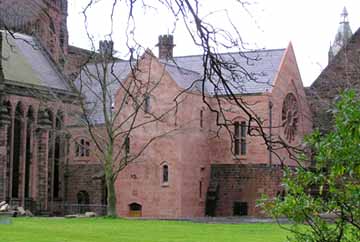 Nearly two years later, in June 2004, the external work on the new song school was pretty much finished and handsome it looked too, as may be seen in our photograph below. (In the years since this picture was taken, the stone has darkened somewhat and now blends better with the rest of the building). A considerable amount of money remained to be raised to pay for the work (you and I would be wise enough to ensure wecould afford it before we built an extension to our home, but here, it seems, they do their housekeeping differently)- and, doubtlessly not unconnected with this was their announcement that they intended to impose compulsory admission charges for visitors to the Cathedral from the following Summer. Chester residents would still be granted free admission to Our Father's House- but only upon the production of their 'Charisma Card' (a local trader's loyalty card which offers discounts in shops, restaurants and the like) - as will "bona fide worshippers"...
Nearly two years later, in June 2004, the external work on the new song school was pretty much finished and handsome it looked too, as may be seen in our photograph below. (In the years since this picture was taken, the stone has darkened somewhat and now blends better with the rest of the building). A considerable amount of money remained to be raised to pay for the work (you and I would be wise enough to ensure wecould afford it before we built an extension to our home, but here, it seems, they do their housekeeping differently)- and, doubtlessly not unconnected with this was their announcement that they intended to impose compulsory admission charges for visitors to the Cathedral from the following Summer. Chester residents would still be granted free admission to Our Father's House- but only upon the production of their 'Charisma Card' (a local trader's loyalty card which offers discounts in shops, restaurants and the like) - as will "bona fide worshippers"... 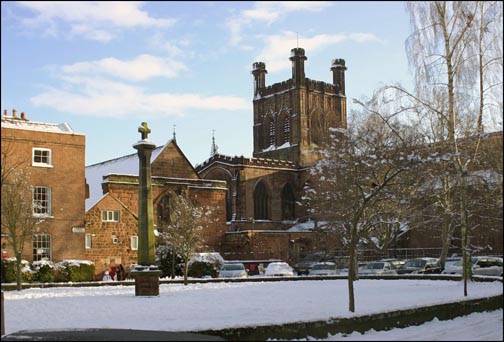 Doubtless, other great cathedrals around Britain
have resorted to inposing compulsory charges in order to raise money- the tourist trap that is
Doubtless, other great cathedrals around Britain
have resorted to inposing compulsory charges in order to raise money- the tourist trap that is 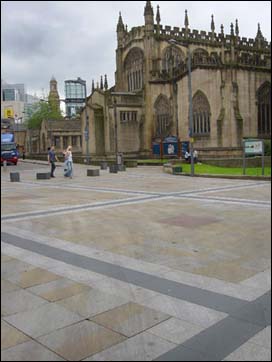 Any of our readers familiar with the bleak, windswept area, replete with concrete block for people to sit on and the snapped-off stumps of saplings for them to look at, surrounding poor old
Any of our readers familiar with the bleak, windswept area, replete with concrete block for people to sit on and the snapped-off stumps of saplings for them to look at, surrounding poor old 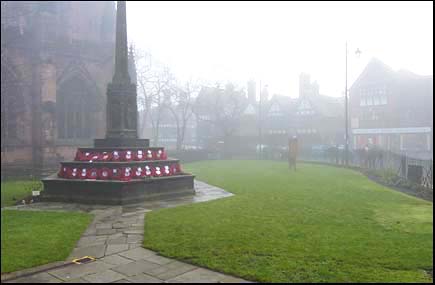 The church's view? "The Cathedral is a fascinating and intriguing complex making a significant contribution to the life of the city, spiritually, culturally and economically", said the Dean of Chester, the Very Rev Professor Gordon McPhate. "However, it is often said" (by whom? Please tell us) "that it is 'hidden in full view' and we want to improve its setting and allow greater appreciation and easier access". Hidden in full view? The building is enormous and dominates the city centre; extremely difficult to miss. Easier access? All the visitor is currently required to do is walk through well-signposted doors and hand over money in order to be allowed the privilege of entering Our Father's House. What could be simpler?
The church's view? "The Cathedral is a fascinating and intriguing complex making a significant contribution to the life of the city, spiritually, culturally and economically", said the Dean of Chester, the Very Rev Professor Gordon McPhate. "However, it is often said" (by whom? Please tell us) "that it is 'hidden in full view' and we want to improve its setting and allow greater appreciation and easier access". Hidden in full view? The building is enormous and dominates the city centre; extremely difficult to miss. Easier access? All the visitor is currently required to do is walk through well-signposted doors and hand over money in order to be allowed the privilege of entering Our Father's House. What could be simpler? This writer can, and does, only speak for himself (and apologises a hundred times over if any of his views regarding these matters offends in any way), but when he visits England's great cathedrals, that's what he's there to visit. He wants the spiritual, the rarified atmosphere of a place set aside from the money-grubbing outside world, the feeling of continuity across centuries. A place to commune with Our Father in peace. He rather likes the venerable, the dusty, the timeworn. He doesn't want vulgar nick-nack shops, restaurants, audio-visual presentations. He doesn't want futuristic "dinosaur egg" (surely a contradiction in terms?) visitor's centres. He decidedly doesn't want the turnstiles that intimidate and exclude the poor. We're told there's a £7.5 million budget for these 'improvements' and yet the church cries poverty in order to defend its indefensible admission charges. Improve the environment of St. Werburgh Street and the Cathedral precinct by all means but be subtle about it! Lay some cobbles, plant some trees, put in some seats where our visitors and locals can sit and soak up the atmosphere of this wonderful building and its surroundings. Think again about the Dean & Chapter of the 1920s who did away with admission charges and threw open God's House to welcome the harrassed city worker, the pensioner, the traveller, the poor man, the child: "the cathedral open and free". Have the faith to believe that when your visitors feel really included and welcome, they will certainly give generously.
This writer can, and does, only speak for himself (and apologises a hundred times over if any of his views regarding these matters offends in any way), but when he visits England's great cathedrals, that's what he's there to visit. He wants the spiritual, the rarified atmosphere of a place set aside from the money-grubbing outside world, the feeling of continuity across centuries. A place to commune with Our Father in peace. He rather likes the venerable, the dusty, the timeworn. He doesn't want vulgar nick-nack shops, restaurants, audio-visual presentations. He doesn't want futuristic "dinosaur egg" (surely a contradiction in terms?) visitor's centres. He decidedly doesn't want the turnstiles that intimidate and exclude the poor. We're told there's a £7.5 million budget for these 'improvements' and yet the church cries poverty in order to defend its indefensible admission charges. Improve the environment of St. Werburgh Street and the Cathedral precinct by all means but be subtle about it! Lay some cobbles, plant some trees, put in some seats where our visitors and locals can sit and soak up the atmosphere of this wonderful building and its surroundings. Think again about the Dean & Chapter of the 1920s who did away with admission charges and threw open God's House to welcome the harrassed city worker, the pensioner, the traveller, the poor man, the child: "the cathedral open and free". Have the faith to believe that when your visitors feel really included and welcome, they will certainly give generously. 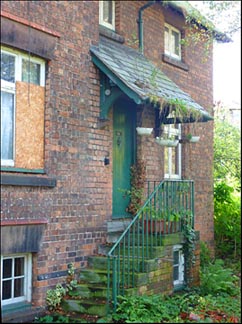 In late July 2011, the Chester Chronicle published an embarrassingly-leaked email from the Cathedral's Chief Executive Annette Moore in the run up to an important visit from
In late July 2011, the Chester Chronicle published an embarrassingly-leaked email from the Cathedral's Chief Executive Annette Moore in the run up to an important visit from  Chester City Ward Councillor Samantha Dixon: "This is a facelift but what the patient really needs is a heart transplant". We liked this.
Chester City Ward Councillor Samantha Dixon: "This is a facelift but what the patient really needs is a heart transplant". We liked this.